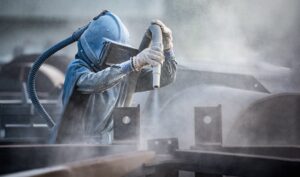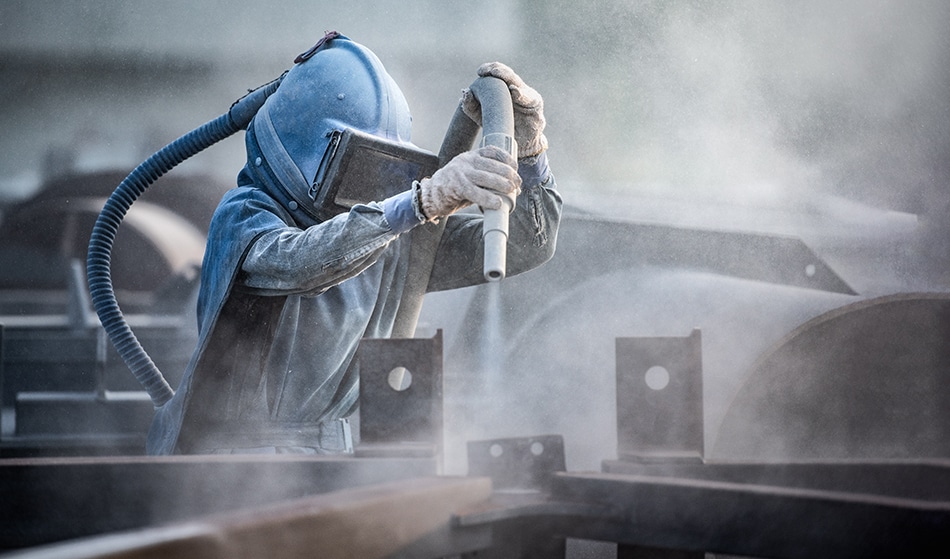
Abrasive blasting or blast finishing, with all its variations, can provide enough power to remove heavy surface materials, or can be gentle enough to take a print off paper without penetration. Typically, blasting provides one of three general – as a surface finishing, surface preparation, or surface modification process.
As a surface finishing process:
• Removing surface contamination
• Creating a specific finish on the desired surface
As a surface preparation process:
• Roughening surfaces for the application of paint
• Removing surface irregularities
As a surface modification process, it increases compressive stresses on the surface:
• Providing increased fatigue life
• Decreasing susceptibility to stress corrosion
• Correcting distortion
• Forming structural steel and plate.
Regardless of its uses, there are only two basic methods of blasting – wet or dry with the major focus for dust control being of this summary will be on the dry blasting method.
WET BLASTING
Wet blasting is a precision finishing operation normally consisting of air-blasted slurries of fine abrasive suspended in chemically treated water. Controlled wet blasting can avoid metal removal and can hold dimensional tolerance to within 3 microns. It can also hone multi-tooth hobs, and finish fragile items such as hypodermic needles. Wet blasting equipment is usually cabinet style, and reserved for small, delicate workpieces.
Common Applications / Equipment in Dry Blasting and Shot Blast
Manual Cabinet, Rotary Basket, Rotary Table, Automated Feed Booths, Tumblers, Barrels, Oscillation Units, and Blast Rooms.
FEED MATERIALS
- Media used in dry blasting processes can vary from facility to facility and from day to day within a facility, depending on the specific needs of the customer. The media used ranges in size from 20 to 6000 mesh and the style of blasting will determine the size of particulate collected.
- Dust collection equipment selection must consider particulate from both the blasted material blasting material. The blasted materials can make up as much as 95% of the collected contaminate in the dust collector so fire, explosion, corrosive, or toxic considerations for the blasted material may define requirements for a specific application.
BLASTING STYLES
Styles of dry blasting will determine the loading conditions of the dust collector. Blasting styles include:
- Direct pressure: provides a uniform finish in a short time, and offers more precise system controls, making the machines appropriate for heavy finishing jobs. This style removes heavy mill scale or paint reaches hard to reach recessed areas, odd shapes, large workpieces, and high-speed production. Consequently, this style produces heavy dust loading conditions.
- Induction (suction): used for light to medium production, limited space, and/or where moderate budget requirements exist. Some pressure is lost to the media suction requirement; therefore, it is less efficient than the direct pressure style. Usually reserved for cabinet type blasting units, this style does not generate high dust loading. However, if multiple cabinets are exhausted, grain loading can increase significantly.
- The Airless or Blast Wheel: used in heavy production requirements where the need for automated systems and minimal human interface. Parts come to the blast machine either by mechanical coney or are loaded manually into the blast machine. Due to the amount of blast media used, these machines can produce heavy dust loading conditions.
NOTES
Most blast media is used several times with only 5% – 8% of the media “spent” during a single blast sequence. Consider the material blasted with every application being careful not to mix incompatible materials in the same collector.
Blast media is abrasive, so apply abrasion-reducing features with each collector.
Due to the extremely wide variety of materials blasted, the various blast media available, and the differences in styles of blasting, not all applications are addressed in this report.
Definitions:
- Media – Substance used in an abrasive blasting operation. Media may be in granular, powder, pellet, or shard form depending upon specific customer requirements.
- Abrasive Blasting – The forcible application of an abrasive media to a surface by pneumatic pressure, hydraulic pressure, or centrifugal force.
- Blast cleaning barrel – A complete enclosure which rotates on an axis, or which has an internal moving tread to tumble the parts, in order to expose various surfaces of the part to the action of the blasting spray.
- Blast cleaning room – A complete enclosure in which blasting operations are performed and where the operator works inside of the room to operate the blasting nozzle and direct the flow of the abrasive material.
- Blasting cabinet – An enclosure where the operator stands outside and operates the blasting nozzle through an opening or openings in the enclosure.
- Rotary blast cleaning table – An enclosure where the pieces to be cleaned are positioned on a rotating table and are passed automatically through a series of blast sprays.

